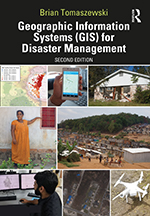
|
Chapter 8: Geographic Information Systems and Disaster Recovery |
This is the companion website for Chapter 8: Geographic Information Systems and Disaster Recovery from the book Geographic Information Systems (GIS) for Disaster Management (second edition). This page contains links to any technical video walk throughs contained in the chapter, slides for the chapter, chapter test questions, and other additional materials.
Chapter Abstract
This chapter presents the concept of geographic information systems (GIS) for disaster recovery. The ideas of short -term and long-term disaster recovery are first presented for insight on the time scales for specific use of GIS for disaster recovery. The geographical aspects of disaster recovery is discussed next via topics such as resilient recovery, the transition from temporary housing to permanent housing and debris removal, and restoring community sense of place. Disaster recovery case studies on GIS for community development block grant programs and (b) long term refugee recovery efforts follow. Next is a technical discussion on the use of GIS to support disaster recovery via topics that include geocollaboration, restoring critical infrastructure, networking algorithms, and defining service areas for debris cleanup. The chapter next discusses non-technical uses of GIS for the broader public participation in disaster recovery activities such as using paper maps and a Story Maps for ‘maptivism’ case study on long-term refugee recovery. Chapter topics are then rounded out with a conceptual and practical discussion on the transition from recovery to mitigation. The chapter concludes with a technical exercise on sustainable debris removal with networking analysis.
Chapter Objectives: Upon chapter completion, readers should be able to:
- understand the different time scales at which disaster recovery operates and the implications of those time scales for the use of geographic information systems (GIS) and disaster recovery;
- discern various geographical aspects of disaster recovery and how those geographical aspects might be uniquely supported with GIS;
- understand the concept of Geocollaboration and how this theoretical idea is particularly relevant to disaster recovery and also to the use of GIS in other disaster management phases;
- identify specific GIS techniques that can be used to support disaster recovery such as networking and routing for restoring critical infrastructure;
- understand the unique role that GIS can play in recovery planning processes that involve community members;
- discern the overlaps between disaster recovery and disaster mitigation and how GIS and corresponding spatial data can serve both disaster recovery and mitigation needs.
Follow these links to access Chapter 8: Geographic Information Systems and Disaster Recovery materials:
- Chapter 8 Slides (.pptx, 6.9 mb)
- Exercise 8-1: Sustainable Debris Removal with Networking Analysis video walkthrough
- Chapter 8 Test Bank (.docx, 21 kb) | Chapter 8 Test Bank (.pdf, 157 kb)
For information on this chapter, purchase the book from Routledge Press »